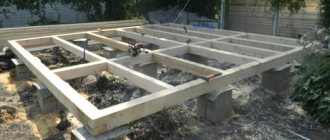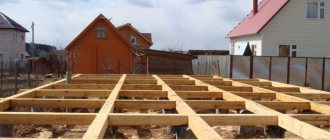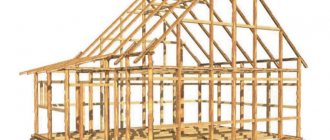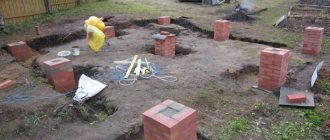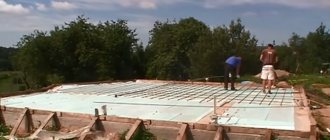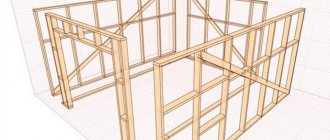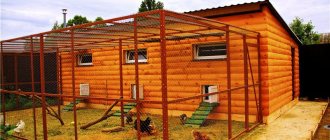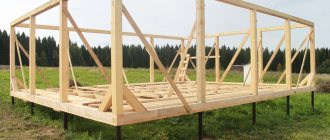What is a columnar foundation?
Columnar foundations are simply ideal for light buildings (garages, garden houses, sheds, bathhouses). However, with the correct calculations, frame or foam concrete cottages can be installed on them. But for a brick house with thick walls, it is better to look for another option.
But much in this matter depends on the total weight of the building. After all, slate or ceramic roof tiles are much heavier than roofing felt or light metal profiles. In the design of a columnar foundation and the entire house, it is necessary to take into account all materials used in construction - from the floor and walls to the roof. And you should trust only a qualified specialist to prepare calculations.
Example
Structurally, such a base is a pile field of pillars made of various materials and connected at the top by a grillage. If the soil on the site is unstable, then building a foundation for the house in the form of a buried reinforced concrete monolith is not very rational. Columnar piles have a big advantage here in terms of low cost of work. With proper design, they are not afraid of high groundwater and soil heaving.
How to do it yourself?
To make formwork with your own hands, you first need to decide on the type of material. Any designs require reliable tightening, so special studs will be needed. For waterproofing, you can use laminated plywood.
Homemade structures are not capable of providing high rigidity, so they cannot be used for residential buildings. To minimize solution leakage, you need to prepare fastening elements: supports and wedges.
The calculation of the thickness of the layer of materials is determined based on the distance between the columns, the weight of the poured solution and the resistance characteristics of the material.
The easiest way to create formwork is by digging a trench and placing panels vertically at the bottom . The shields will be supported by special supports. The stakes are installed on dense surfaces that are not prone to crumbling. If the soil is not dense, braces should be used.
The thickness of the board is usually 25 cm, since it is difficult to independently determine the characteristics of the concrete mixture in order to make an accurate calculation.
The required number of fasteners and boards is calculated based on the height of the fill and the length of the base tape of the building. The length doubles. Filling is carried out in 2 stages, so the calculation must be done twice .
Work order
The construction of the foundation is carried out in several stages:
Site marking . Using a building plan, boundaries should be marked using cords.- Digging a trench . The depth must be determined taking into account the foundation cushion and the level of soil freezing. The bottom and walls of the dug trench are compacted or treated with geotextiles.
- Adding a layer for the pillow . Materials spilled with liquid cement or concrete can withstand the maximum load. Sand and crushed stone are used for the base of the pillow.
- Installation of formwork . The gaps between parts should be up to 2 mm.
After the formwork is erected, the installation of reinforcement begins (the reinforcing mesh must maintain a protective layer between the material and the environment), pouring and vibration compaction.
Types of columnar foundation
The pillars of the foundation under consideration using the technology of immersion in the ground can be hanging or retaining. In the first case, short supports are held in the ground due to frictional forces, and in the second, they are made longer, so that the base rests on a solid soil layer. Due to the need to carry out complex calculations and load a large number of piles, the hanging option is practically not used in private housing construction.
According to the structural location of the grillage, they are divided into:
- Not buried - the grillage part hangs on poles above the ground at a height of up to half a meter;
- Shallow - the grillage is immersed in the soil by 40–60 cm;
- Recessed - with the laying of reinforced concrete tape on supports below the freezing depth of the soil at the construction site.
Shallow foundation diagram
The latter option provides little benefit in terms of saving on building materials. In the construction of country houses, such a foundation is used very rarely. Most often, for cottages, builders choose a non-recessed grillage, hanging along the entire length on columnar supports. This technology eliminates problems with heaving and makes it possible to make a grillage structure from a steel channel, which greatly simplifies and speeds up the process of constructing a foundation.
Advantages and disadvantages of a pillar foundation
The list of advantages of a columnar foundation is quite extensive, it includes:
- No need for special lifting equipment;
- Possibility of constructing a pile field on slopes;
- High construction speed;
- No need for preparatory leveling of the construction site;
- Simplicity of technology, allowing you to do it yourself;
- Excellent pole heaving resistance;
- Cheap design.
If it is designed and done correctly at the construction stage, then it will quietly serve for more than half a century. He is not afraid of seasonal heaving of the soil, as long as the rise of the earth does not affect the grillage. And the technology of work is so simple that it is quite possible to do everything alone, without involving third-party highly professional and expensive installers.
Among the disadvantages of pillar foundations for houses outside the city are:
- Low stability of supports to lateral loads;
- Restrictions on soils (you should not choose for swampy areas).
- Limitations on load-bearing load (for heavy concrete or brick houses, such a foundation is not suitable by definition);
- Impossibility of building a basement.
The main disadvantage of this type of pile-strip foundation is the possible destruction of supports under strong lateral influences. If the site has highly mobile soils in the horizontal plane, then the diameter of the piles will have to be greatly increased, which will affect the cost of construction. Or you will generally need to select a different type of foundation for the house being built.
Cons - side loads
How to avoid mistakes?
Mistakes made during the installation of formwork lead to damage, destruction of the building and a reduction in its service life.
Some do not pay due attention to design, which is a gross violation. To properly create formwork, the designer must take into account the maximum load, quantity and quality of concrete.
The type of foundation is of great importance and there are no “universal” foundations. If the soil is soft, the pile option is not suitable, nor are metal piles for organic soil .
Therefore, it is necessary to carefully analyze the composition of the soil and the possibility of using a specific material. Depending on this, you should choose the type of formwork.
Many problems can also arise during the installation process itself. To create a frame for a reliable foundation, you should consider the following rules:
Before pouring, you should make sure that the structure is tight;- there should be no dirt or ice in the area where the formwork is installed;
- you need to cut off the top layer of soil;
- do not add more soil for leveling;
- start installation from the corners;
- the surface of the structure must be flat.
You will find a lot of important and useful information about columnar foundations here.
Instructions - how to arrange the foundation yourself
Columnar foundations are erected using technology in four stages:
- Excavation work involves drilling holes for support pillars and placing sand cushions at the bottom.
- Installation of permanent formwork for foundation supports followed by pouring concrete or laying them out of brick or concrete blocks.
- The device for this type of pile-grillage foundation is an upper load-distributing part made of reinforced concrete, steel channel or wood.
- Waterproofing the entire structure and covering the supports around the perimeter of the building with siding or corrugated sheets.
Everything is quite simple, but there are a number of nuances in this process. The first of them is that, regardless of the level of the grillage, the retaining piles of the columnar version of the foundation for a private low-rise building should be immersed below the freezing point. To speed up the work, in some cases it would be best to use specialized equipment with a drill.
The base supports themselves can be made of:
- Reinforced concrete poured into an asbestos-cement pipe;
- Brick;
- FBS (factory-made reinforced concrete blocks for foundations);
- Natural stone.
Below is a step-by-step photo instruction for a columnar foundation on foam blocks:
We transfer the foundation plan to the area - we mark future boundaries with pegs
Digging holes
We fill the holes with crushed stone, top with sand and spill them several times and repeat the procedure of filling with sand.
We place the first 4 blocks on the pillow in the corners and align them according to the lace and size
We substitute the second block and level it
Using a hydraulic level, we measure the zero level of the foundation - its height
We set the following levels of blocks of our foundation
We make all the other pillars according to the level
We lay roofing felt on the posts for waterproofing
It is also possible to use steel screw piles. But this will already be one of the variations of the pile-screw foundation. Previously, supports were even made from moisture-resistant larch. However, today most private developers prefer to install something more durable and concrete under their house.
The supports are placed at intervals of 1.5–2.5 meters so that they are located at the corners of the building, at the intersection of internal walls and load-bearing beams, as well as under stoves and fireplaces. These are the main load points. The grillage is quite capable of distributing some of them throughout the entire structure. But ideally, the main weight should fall precisely on the support piles on which the columnar-strip foundation rests.
When choosing a brick, you should immediately exclude the silicate variety. And ceramic should be taken with the highest possible frost resistance. In general, if you don’t want to mix and pour concrete, then it is best to choose FBS. These blocks were originally intended for the construction of foundations for various buildings.
By design, the concrete grillage on top of the pillars is a small strip foundation. A separate formwork is assembled for it with reinforcement made of 10–12 mm steel rods placed in it. After tying them together, the finished reinforcing belt will only need to be filled with concrete mortar with a grade of at least M-300. At the same time, for wooden buildings, the grillage part is often made entirely of timber. In many cases, it is quite enough to redistribute loads.
To waterproof the elements of a columnar base, you can use roofing material or liquid bitumen mastic. Even soft tiles are suitable if they were left unused when covering the roof of an already constructed building.
Kinds
Features of the arrangement of supported foundations and the choice of deck type are determined by the type of construction, the nature of the soil and other operational requirements. Decks come in different sizes and sections. There are rectangular, square, and round supports.
Columns can be made of concrete (reinforced concrete), rubble concrete, block material, rubble stone, brick. According to the manufacturing technology used, foundations on decks are classified into the following types:
- monolithic, when holes are dug, formwork is installed and concrete mortar of a grade not lower than M400 is poured in layers;
- prefabricated, when ready-made elements from blocks, bricks or stones of a certain brand are used.
Diagram of a columnar foundation.
The depth of placement determines certain types of supporting foundations:
- Non-buried foundations on pillars, when the base is located on the ground or sand cushion. Such foundations are distinguished by their economical construction, but are used exclusively for the construction of one-story buildings from lightweight materials on weak and non-heaving soils.
- Recessed foundations, during the construction of which the columns are laid to a depth to or below the freezing point of the soil. This design is used on heaving soils with loams or clays. They are characterized by the least cost-effectiveness.
- Shallow, the depth of which is 0.5 - 0.7 parts of the depth from the freezing point of the soil. Half of the foundation is a monolith of a certain shape, and the second is a cushion of sand and gravel. Suitable for development on low- and non-clayey lands.
According to the structural features, foundations can be with or without a fastening beam. The grillage is attached to the post and distributes the load from the total mass of the house evenly over the base. Grillage beams prevent decks from tipping over due to horizontal soil movement. However, this element significantly increases the cost of construction and increases the time for arranging the foundation.
Most non-massive buildings are erected on supporting foundations without a grillage. In this case, the first trim is mounted directly on the decks, on top of the waterproofing layer. However, this design is less resistant to horizontal soil shifts and overturning loads.
Return to contents
Where is it better to use a pillar foundation?
It is not difficult to build a columnar foundation with a grillage on top of the supports yourself. The step-by-step instructions given above and the nuances of making such a support described above will help even a novice builder cope with the task. Everything is completed in just a few days. True, you will have to wait up to a month until the concrete in the grillage hardens, but there is no other way.
Example of a house
If you plan to build a lightweight structure, then it will be most profitable to make a similar foundation for it in terms of cost and time of work. You can even prepare the project yourself. But it is better to order calculations for the foundation under a massive cottage from a professional.
